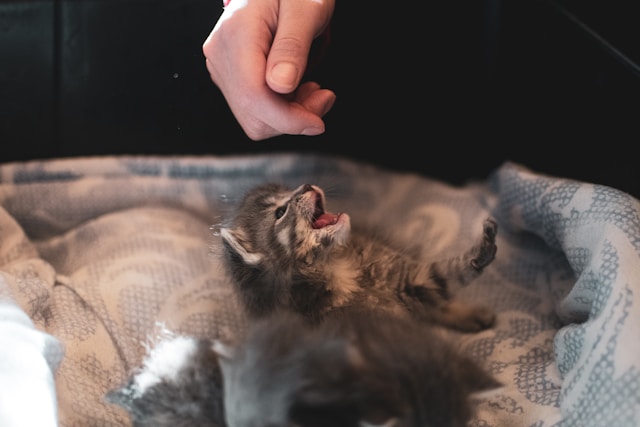How Cats Choose Their Favorite Person: The Psychology Behind Feline Affection

Introduction
Cats are often perceived as enigmatic creatures, balancing on the edge of independence and affection. One of the most intriguing aspects of feline behavior is how they choose their favorite person. Unlike dogs, whose loyalty is often more straightforward, cats have a more complex approach to forming bonds with their human companions. Understanding why a cat favors one person over others involves delving into feline psychology and examining the subtle nuances of their behavior and social interactions.
In this blog, we’ll explore the psychological and behavioral factors that influence how cats select their favorite person. We’ll break down the science behind feline affection, discuss the impact of human behavior on cat preferences, and offer practical tips for strengthening your bond with your feline friend.
The Psychology of Feline Affection
1. Understanding Cat Social Structures
Cats are often thought of as solitary creatures, but they do have complex social structures, especially in multi-cat households. Unlike dogs, whose social structures are more hierarchical, cats have more fluid and adaptable social interactions. In the wild, domestic cats form colonies around abundant resources, and their social bonds are influenced by factors such as territory, food, and safety.
In a home environment, a cat’s social structure is influenced by their human companions. The cat’s favorite person is often the one who provides the most positive reinforcement and meets their needs most effectively.
2. Attachment Theory in Cats
Attachment theory, originally developed to explain human relationships, also applies to cats. Studies have shown that cats form attachment bonds similar to those seen in children and their primary caregivers. These bonds are characterized by a cat’s preference for their favorite person when seeking comfort or security.
Cats often display attachment behaviors such as following their favorite person around the house, seeking out their company, and becoming more relaxed and confident in their presence. These behaviors indicate that the cat feels secure and trusts their favorite person more than others.
3. The Role of Early Socialization
A cat’s early socialization period plays a crucial role in shaping their future relationships with humans. Kittens that experience positive interactions with people during their critical socialization period (between 2 and 9 weeks of age) are more likely to form strong bonds with their human caregivers.
If a kitten has a particularly positive or negative experience with a person during this time, it can significantly impact their preference for that person later in life. For example, a kitten that receives gentle handling and positive reinforcement from one person may be more likely to bond closely with them as an adult.
Behavioral Factors Influencing Cat Preferences
1. The Influence of Food and Treats
One of the most direct ways to a cat’s heart is through their stomach. Cats often favor the person who feeds them, provides treats, and generally meets their nutritional needs. This association between feeding and affection is rooted in the cat’s need for resources and their natural instinct to bond with those who provide them.
However, food alone is not enough. The overall quality of interactions and the emotional bond established through regular positive experiences play a more significant role in determining a cat’s favorite person.
2. Consistency and Routine
Cats thrive on consistency and routine. The person who provides regular care, maintains a predictable schedule, and is consistently gentle and reliable is more likely to become a cat’s favorite. Cats appreciate routine because it creates a sense of security and predictability in their environment.
Being consistent with feeding times, play sessions, and grooming routines helps strengthen the bond between a cat and their favorite person. Any sudden changes or irregularities in these routines can lead to stress and potentially affect the cat’s attachment.
3. Understanding Body Language and Communication
Cats communicate primarily through body language, and their favorite person is often the one who understands and responds to these signals effectively. Recognizing and respecting a cat’s body language can strengthen the bond and increase the likelihood of becoming their favorite.
Key signs of a cat’s affection include purring, kneading, slow blinking, and rubbing their head or body against their favorite person. Being attentive to these cues and responding with gentle, positive interactions fosters trust and affection.
Factors Affecting Human-Cat Relationships
1. Personalities and Temperament
A cat’s personality and temperament play a significant role in their preference for certain people. Some cats are naturally more social and affectionate, while others may be more reserved or independent. The personality traits of the human caregivers also impact this dynamic.
Cats often gravitate towards people who match their own temperament. For example, a calm and patient person may be more likely to connect with a shy or anxious cat. Conversely, a playful and energetic person might bond better with a more active and adventurous cat.
2. Previous Experiences and Associations
A cat’s past experiences with different people can influence their current preferences. Cats that have had positive experiences with specific types of individuals—such as those who are gentle, patient, or playful—are more likely to form strong bonds with people who exhibit similar characteristics.
On the other hand, negative experiences with certain individuals or types of behavior can lead to distrust or avoidance. Understanding and respecting a cat’s past experiences can help in building a stronger, more positive relationship.
3. Individual Attention and Bonding
Spending quality time with a cat, engaging in interactive play, and providing individual attention can enhance the bond between a cat and their favorite person. Cats value one-on-one interactions and often show a preference for those who actively engage with them and provide stimulation and enrichment.
Building a bond with a cat involves more than just meeting their basic needs; it requires investing time and effort into understanding their preferences and providing them with positive, enjoyable experiences.
Tips for Strengthening Your Bond with Your Cat
1. Engage in Interactive Play
Interactive play is a crucial component of building a strong bond with your cat. Activities like using feather wands, laser pointers, or puzzle toys provide mental and physical stimulation, and they create opportunities for positive interactions. Regular play sessions help strengthen the connection between you and your cat.
2. Respect Their Space and Boundaries
Understanding and respecting your cat’s personal space and boundaries is essential for building trust. Cats appreciate having a safe space where they can retreat when they need to. Avoid forcing interactions or handling your cat when they are not in the mood for socializing.
3. Provide Positive Reinforcement
Positive reinforcement, such as treats, praise, and gentle petting, encourages desirable behaviors and strengthens the bond between you and your cat. Reinforcing good behavior with rewards helps your cat associate you with positive experiences.
4. Be Patient and Consistent
Building a strong bond with a cat takes time and patience. Consistent, gentle interactions and maintaining a predictable routine contribute to a sense of security and trust. Avoid abrupt changes and be patient as you work to strengthen your relationship.
5. Understand and Respond to Their Communication
Paying attention to your cat’s body language and vocalizations helps you understand their needs and preferences. Responding appropriately to their signals—whether it’s through play, affection, or respecting their space—fosters a deeper connection and enhances your bond.
Conclusion
Understanding how cats choose their favorite person involves exploring the intricate dynamics of feline behavior and psychology. From early socialization to consistent care and positive interactions, a variety of factors contribute to a cat’s preference for one person over others. By being attentive to your cat’s needs, respecting their boundaries, and engaging in meaningful interactions, you can strengthen your bond and potentially become your cat’s favorite person.




